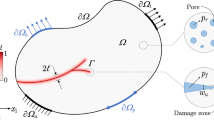Abstract
The standard definition of the J integral leads to a path dependent value in the presence of a residual stress field, and this gives rise to numerical difficulties in numerical modelling of fracture problems when residual stresses are significant. In this work, a path independent J definition for a crack in a residual stress field is obtained. A number of crack geometries containing residual stresses have been analysed using the finite element method and the results demonstrate that the modified J shows good path-independence which is maintained under a combination of residual stress and mechanical loading. It is also shown that the modified J is equivalent to the stress intensity factor, K, under small scale yielding conditions and provides the intensity of the near crack tip stresses under elastic-plastic conditions. The paper also discusses two issues linked to the numerical modelling of residual stress crack problems-the introduction of a residual stress field into a finite element model and the introduction of a crack into a residual stress field.
Similar content being viewed by others
References
Milne, I., Ainsworth, R.A., Dowling, A.R. and Steward, A.T. (1988). Assessment of the intensity of structures containing defects. Int. J. Pres. Ves. & Piping 32, 3–104.
BSI (1999). Guide on methods for assessing the acceptability of flows in structures. Guide B57910–1999.
Kumar, V., Schumacher, B.I. and German, M.D.(1984). Development of a procedure for incorporation secondary stress in the engineering approach, Section 7 in EPRI Report EPRI NP-3607.
Anderson, T.L. (1995). Fracture Mechanics Fundamentals and Applications, CRC Press, 2nd edition.
Rice, J.R. (1968). A path independent integral and the approximate analysis of strain concentration by notches and crack, J. Appl. Mech. 35, 379–386.
Ainsworth, R.A., Neale, B.K. and Price, R.H. (1978). Fracture behaviour in the presence of thermal strains, Proc. Int. Conf. on Tolerance of Flaws in Pressurised Components, pp. 171–178.
Shih, C.F., Moran, B. and Nakamura, T. (1986). Energy release rate along a three-dimensional crack front in a thermally stressed body. Int. J. Fracture 30, 79–102.
Wilson, W.K. and Yu, I.W. (1979). The use of the J-integral in thermal stress crack problems. Int. J. Fracture 15, 377–387.
ABAQUS V. 5.6 (1996). Hibbitt, Karlsson and Sorensen Inc., Providence, RI.
Li, F.Z., Shih, C.F. and Needleman, A. (1985). A comparison of methods for calculating energy release rates. Engng. Fracture Mech. 21, 405–421.
Crisfield, M.A (1994). Non-linear Finite Element Analysis of Solids and Structures Vol. 1, Wiley and Sons, New York.
Buecker, H.F. (1971). Weight function for the notched bar, Z. Angewandte Mathemat. Mechan. 51, 97–109.
Miller, A.G. (1988). Review of limit loads of structures containing defects. Int. J. Pres. Ves. & Piping 32, 197–327.
Qi, D.M. (1992). Recommendations on the treatment of residual stress in PD6493 for the assessment of the significance of weld defects. Engng. Fracture Mech. 41, 257–270.
Finch, D.M. and Burdekin, F.M. (1992). Effects of welding residual stresses on significance of defects in various types of welded joint. Engng. Fracture Mech. 41, 721–735.
Rice, J.R. and Rosengren, G.F. (1968). Plane strain deformation near a crack tip in a power law hardening material. J. Mech. Phys. Solids 16, 1–12.
Hutchinson, J.W. (1968). Singular behavior at the end of a tensile crack in a hardening material. J. Mech. Phys. Solids, 16, 13–31.
O'Dowd, N.P. (1995). Applications of two parameter approaches in elastic-plastic fracture mechanics. Engng. Frac. Mechanics 52, 445.
O'Dowd, N.P. and Sumpter, J.D.G. (1996). Effect of thermomechanical loading on near tip constraint. J. de Physique IV, Colloque C6, Vol. 6, C6–539–548.
Hancock, J.W.(1999). Constraint based Failure Assessment Diagrams for Primary and Secondary Loading, ASME Conference on Pressure Vessels and Piping, August 1–5 Boston.
Author information
Authors and Affiliations
Rights and permissions
About this article
Cite this article
Lei, Y., O'Dowd, N. & Webster, G. Fracture mechanics analysis of a crack in a residual stress field. International Journal of Fracture 106, 195–216 (2000). https://doi.org/10.1023/A:1026574400858
Issue Date:
DOI: https://doi.org/10.1023/A:1026574400858




